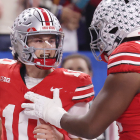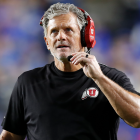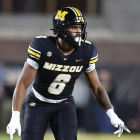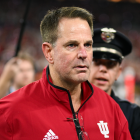When summer turns to survival: Depth crisis -- hello, injury bug -- hits college football amid portal era
Could an August transfer portal window be a balm to the fall camp injury bug? "Hell no," says one coach

College coaches have never been busier, but when the spring turns to summer and temperatures rise, they're at their most comfortable.
It's then -- and only then -- rosters across the country are finalized. No transfer portal can rob rosters, no signing day can rip away commitments. During those few months everything is calm on campus, and coaches feel safe formalizing plans and shaping the identity of their team.
And then mid-August hits the calendar. The doldrums of preseason camp. The 10th, 11th and 12th practices bear fruit in competition but also result in inevitable injuries, the result of consecutive days of wear and tear and physical and mental fatigue.
A rash of injuries strikes every team at every level of the sport, including the bluebloods. No one is immune to the injury bug.
Within the last week, the bug struck with a vengeance:
- Texas starting running back CJ Baxter and freshman backup Christian Clark were lost to season-ending injuries, forcing Steve Sarkisian to move linebacker Derrion Gillette to offense. The Longhorns will begin the season with three scholarship running backs on the roster and are likely to change their offensive philosophy.
- Chip Trayanum, Kentucky's prized transfer running back from Ohio State, is expected to miss the Wildcats' first two games after breaking a hand at practice, according to Kentucky Sports Report.
- Texas A&M running back Rueben Owens, a five-star recruit in the 2023 class, will miss the season. Texas A&M is well-positioned with a deep stable, still, especially because new coach Mike Elko brought in transfer EJ Smith, the son of Emmitt Smith, from Stanford this offseason.
- Last week, Notre Dame and Nebraska lost their star left tackles to season-ending injuries. The impact of the loss of Fighting Irish left tackle Charles Jagusah was perfectly described by Irish Illustrated's Tim Prister as a "sopping-wet blanket over fall camp."
- Oklahoma's Jayden Gibson, a breakout candidate at receiver, will miss the entire season.
Preseason injuries are nothing new, but the impact certainly feels different in 2024.
"I feel like we have less depth than we've ever had," Georgia's Kirby Smart told reporters Tuesday. "That's kind of a common theme talking to other coaches I talk to. I call it the deterioration of football because every year we've been here, I feel like we've had more players capable of going in and playing winning football. Every year that goes down. We've got to keep working to increase that number."
No one is crying for No. 1 Georgia, the bluest of bluebloods, but Smart has a point – and it's also being debated in athletic departments across the country today. Starting in 2025, roster sizes will shrink from 130 to 105 players when the House settlement is approved in court. The good news? Powerhouses like Georgia will be allowed to place every player on scholarship, raising the limit from 85, but will that translate to more depth of talent? It sounds like Smart, and others, have their doubts.
(As an aside, Smart doubts rich schools like Georgia will take on the financial burden and reward scholarships to all players, which is interesting, but the bet here is the thirst to beat the competition will force their hand).
There are positives and negatives to the transfer portal, but with the advent of a 105-man roster on the horizon, it poses an interesting question: has the transfer portal already weakened depth across the sport?
And might it get worse when rosters shrink?
Free agency works, yes, but floating from campus to campus is also an occupational hazard. The superstars land on their feet, but backups rarely immediately upgrade their status by changing scenery. For many, Day 1 at a new school is like starting over as a freshman. In only a few short months, they must adjust to a new strength and conditioning program, and new coaches, teammates and schemes. It's difficult. Rarely can one master the craft in six months.
And yet backups at Georgia, Alabama and Texas take one to two years of their development at the bluebloods, enter the portal and land elsewhere looking for new starts. Those aforementioned programs backfill those spots via the portal and recruiting, but the replacements rarely equal the losses. Those programs don't just lose players, they lose irreplaceable years of experience, relationships and equity invested in players that can only be replicated through multiple years of development within the walls of their multi-million dollar facilities. Their depth charts, too, start anew again and again and again, every year because of the portal.
And when those injuries pop up in preseason camp, the sirens sound. "My depth!" the coaches scream. Suddenly, their best laid plans are shredded.
Injuries are inevitable, and so is change. As college football continues to tow the line separating professionalism and academia, one wonders if a window for player transactions in August could be the answer.
"Hell no from me," Arkansas coach Sam Pittman told CBS Sports.
"We don't need to make an already bad situation even worse by adding a portal window in August," said another Power Four head coach.
OK, so maybe not. It's a wild idea, sure, but after four years of reinvention in college athletics, and a dizzying spell of conference realignment and untethered player movement, coaches are scrounging for ways to bolster depth ahead of yet another new wrinkle in the system and the biggest debate behind closed doors: shrinking rosters to 105 players.
"This is a major concern with roster limitations," a Group of Five coach told CBS Sports.
Opening the portal in August is a non-starter -- tampering is already out of control in the winter and spring windows -- and though college players are not signed to contracts like the NFL, a dose of sanity prevails with the prospect of unlimited player movement.
"For some reason we in college want an NFL model without the NFL restrictions," a Group of Five head coach told CBS Sports. "In the NFL, if a team loses their starting QB, they can't call Patrick Mahomes and offer him more money to join their team."
Imagine a big-time quarterback at a lower-level school getting a call from a desperate blueblood needing to replace their injured quarterback in August. That's a much different phone call than in February or March. If Cam Ward can fetch nearly $2 million at Miami – should you believe the scuttlebutt on the street -- imagine the dollars he could pull in August.
The best answer for coaches, particularly those who do most of their dealings through the portal rather than recruiting and developing high school talent, is to win and limit attrition in the offseason.
"Injuries happen," UCF coach Gus Malzahn told CBS Sports. "Overcoming adversity is a big part of football. Coaches have plenty of time to recruit quality depth with the way it is now."
Imagine Ohio State in 2014 if it did not lose two quarterbacks to injury before third-teamer Cardale Jones started the final three games of the Buckeyes' postseason run to a national title. Would the Buckeyes have won the title with JT Barrett or Braxton Miller at quarterback? Maybe. Maybe not. But that's what makes college football unique. Teams fall and sometimes heroes arise from the ashes. The unexpected circumstances are what makes the sport so darn entertaining, even in this new era of portal windows and NIL.
Coaches may not be as powerful today as they were 10 years ago, but they still control those precious few months in the summer. All they can do is prepare for the inevitable.

















